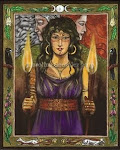Sunday, December 29, 2013
Seshat, Scribe to the Pharaohs
Seshat is the Egyptian Goddess of writing, wisdom, architecture, geometry, astrology and books. Her name translates to mean "She Who Scrivens" or "She Who is the Scribe". Seshat was married to the God of wisdom and writing, Thoth. Together they had a child named "Hornub" which literally means "Gold Horus" so Sheshat was often associated with the Goddess Isis. It is said that Seshat invented writing and that her husband Thoth taught writing to mankind. Sometimes Sehsat is considered to be the feminine aspect of her husband Thoth.
Seshat was the royal scribe to the pharaohs recording all their life achievements, battles, treasures and captives from battle. She really was in many ways a Goddess for royalty. Since she was viewed with such importance among the royal family, Seshat was also involved in the "Sed Festival" which was held in honor of a pharaohs thirty year reign. This ceremony was held to celebrate the continued success of the pharaoh. The scribe Goddess was depicted wearing a leopard skin dress and a papyrus plant as her headdress. She is also seen holding a palm stem which she uses to record the passage of time, especially the time allotted for the life span of the pharaoh.
Seshat also took care of Thoth's library of scrolls and was given the title "Mistress of the House of Books" and is known as the patron Goddess of librarians. Also referred to as "Mistress of the House of Architects", Seshat was said to be involved in a ritual called "stretching the cord" which related to laying out foundations of temples and other important structures. This would determine sacred alignments and precision of the dimensions.
No temple was ever found in her name although her main sanctuary was in Heliopolis. Seshat teaches us that the best way to prepare for the future is to learn from the past so keeping record of events and time is important. She helps writers with their latest writing endeavor and she guides mathematicians and architects. Seshat is also a beneficial Goddess for historians to call upon.
Saturday, December 21, 2013
Winter Solstice, Celebrate the Return of the Sun
Today is the Winter Solstice which is also known as Yule. The Winter Solstice marks the longest night and the shortest day. From this day forward the days will grow longer and nights shorter until the Summer Solstice. Many ancient cultures around the world honored the Solstice such as the Egyptians, Romans, Celts, Norse and many others. The Winter Solstice was a celebration honoring the sun and praying for its return in Spring. Cultures like the Nordic people are said to have large celebrations with lots of food, drink and merry making. This is said to be where the tradition of the Yule log and wassailing originated. Wassailing was essentially where the modern tradition of Christmas caroling comes from. People would go out in the cold of winter and visit peoples homes singing and drinking to their health and to the return of the warmth of Spring. They would pour wine on the ground to encourage the fertility of the crops.
In ancient Rome we have the famous Saturnalia festival which many today say Christmas originated from. This festival was held in honor of Saturn, Roman God of Agriculture and lasted about a week towards the middle to end of December. Saturnalia was said to be a festival with lots of partying, feasting, gift giving and sacrifice. It was also a festival of light to represent the return of the sun. During the Saturnalia the roles of slave and master were said to be reversed so the slaves could experience the luxury of being a free Roman citizen. The Saturnalia was one of the most popular popular festivals on the Roman calendar and was described as being "the best of days".
In honor of the Winter Solstice I found a great tarot spread to try called "The Light of the Solstice". It is in the shape of a circle representing the sun. Use the picture on the right as your guide for the layout. This spread is great for determining how things will go for you in the new year. The card meanings are as follows:
Card 1. What are you hopeful about?
Card 2. What is your hearts desire?
Card 3. Where would you like to be at this point next year?
Card 4. How can you restore balance to your life?
Card 5. How can you open your heart to others?
Card 6. What do you need to do to plan the life you want?
Wishing everyone many Winter Solstice blessings!
Top picture courtesy of Emily Balivet
Sunday, December 15, 2013
Holda, Germanic Goddess of Winter
Holda, also known as Frau Holle, is a Germanic triple Goddess of Winter. She is a Goddess of spinning, the home, protector of children, winter and the weather. Holda is deeply connected to winter and it is said that when she shakes out her feather bed it begins to snow. She is honored at Yule or the Winter Solstice where she is said to fly across the night sky in her wagon and hand out treats to children who have been well behaved. This is where the modern tale of Santa Clause comes to us from.
She is often portrayed with long white hair and a long white cape. She is seen as a beautiful maiden, a caring mother and hag with a long nose and crooked teeth sitting at her spinning wheel. Holda was demonized as a hag and a witch when Europe became Christianized. Women accused of witchcraft were said to be "riding with Holda" and she is often depicted riding across the night sky in her wagon.
She is very much a patroness of the household and domestic arts such as cooking, cleaning, spinning and child care. She is a Goddess for women and is said to help them with their household chores. Holda has no patience for lazy people especially when it came to spinning. She would punish those who were lazy with their chores and reward those who would fall asleep from hard work by completing their spinning for them.
Holda is a protectress of children and would collect the souls of those children who had died too soon. It is said that a procession of children's souls followed Holda's wagon. She has been portrayed as an evil witch who stole the souls of healthy children in later tales and this is where she gets part of her bad reputation.
Holda is said to bring the first snow of winter. She is thought to control many aspects of weather. For example when it rains she is doing her wash and when there is fog it's the smoke from her chimney. She is also associated with animals and the forest. Geese are one of her sacred animals and it is thought that Holda may be the Mother Goose from fairy tales. Other animals that are sacred to her are hounds, pigs and goats.
Call on Holda when you need motivation to finish your housework or when your cooking. You may also pray to her at the winter solstice or ask for her to protect your children. A good way to honor this Goddess is to light a candle to her while you're doing your chores or cooking a meal for your family or if you're so inclined to work with fibers and spinning. You may also call on Holda to bless your home.
Picture courtesy of A Polar Bear's Tale
Monday, December 9, 2013
Magic Monday, Yule Smudge Sticks
In honor of the Winter Solstice I made some smudge sticks with clippings from Fraser Fir trees and sage. Smudge sticks are used to cleanse an area or negative energies before a ritual, personal cleansing or to simply cleanse a new home of any residual energies left by previous owners or spirits. They can also be used to cleanse an area after a fight or after a person with negative energy has left. Smudge sticks are easy to make and many different herbs and tree clippings can be used in them.
For winter solstice smudge sticks you can use traditional winter herbs and trees such as fir, holly, pine, mistletoe and sage for added purifying benefits. I will go over the magical properties of each of these plants below.
Supplies:
- Thread about three or four feet long
- Scissors
- Any two or three of the herbs/plants below
Fir: Part of the evergreen family. Good for prosperity, divination, adds a boost of power to spells and purification. Common tree honored at the Winter Solstice. Represents immortality.
Holly: Sacred Yule herb, also sacred to the Druids and at Yule they were said to decorate heir homes with holly as a way to invite nature spirits such as faeries in. Good for restful sleep, easing the passage of death and spells dealing with death and rebirth.
Pine: Good for purifying a space, wards off negativity, prosperity and fertility. Elevates the spirit and brings on feelings of tranquility and peace. Pine branches were used as the traditional Yule log. Thought to ward off disease.
Mistletoe: Sacred Druid herb, good for protection, fertility, sexual energy and luck. Kissing under the mistletoe originated in Ancient Rome during the festival Saturnalia. It is said that to kiss under the mistletoe insures marriage in the future for the couple.
Sage: Good for purification, healing, wisdom and protection. Can be used to purify a space before ritual or to cleanse an area of any negative energies. Sage is also a healing herb and was used in the Middle Ages to treat fevers, liver disease and memory.
You can read how to make the smudge sticks here: Love of the Goddess
I hope you enjoy creating your Yule smudge sticks! Just a warning, when burning fir be careful as it tends to flame up rather quickly and the flames can jump due to the high oil content in these trees. Use with caution!
Sunday, December 8, 2013
Winner of Giveaway for Yule Stag Altar Tile!
Thank you to all who entered! And the winner is.......TheBlakkDuchess. Congratulations! I enjoyed hearing about what everyone is planning to do for Yule. Many of you are going to watch the sunrise as I will be doing as well! I hope you all enjoyed playing. Have a blessed Yule and Winter season. Enjoy your new altar tile TheBlakkDuchess!
Wednesday, December 4, 2013
Giveaway! Yule Stag Altar Tile!
Since Yule is just around the corner I decided to have a giveaway for one of my hand painted altar tiles. As some of you may know I hand paint different altar tiles and decided to create one in honor of the Winter Solstice. The tile I'm giving away is my Yule Stag altar tile which has been painted on a 4 1/2 inch birch wood circle in colors of green and white. The stag, or deer, was honored at the Winter Solstice and is seen as a representation of the Horned God.
To enter the giveaway simply leave a comment telling us your plans for Yule. I will announce the winner on Sunday! Feel free to check out my shop on etsy to see the other tiles and goodies I create: Sage Art. Good luck to all who enter!
Subscribe to:
Comments (Atom)








